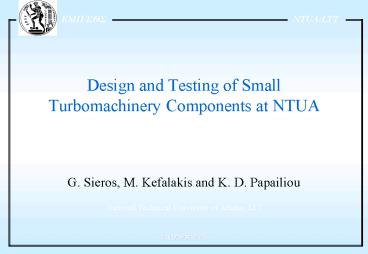Design and Testing of Small Turbomachinery Components at NTUA - PowerPoint PPT Presentation
1 / 32
Title:
Design and Testing of Small Turbomachinery Components at NTUA
Description:
Air conditioning systems. DESIGNS ACTUALLY PERFORMED. Gas turbines Compressor and Turbine Parts ... Air Conditioning Compressor, Turbine. April 29/30 2004. CAME ... – PowerPoint PPT presentation
Number of Views:325
Avg rating:3.0/5.0
Title: Design and Testing of Small Turbomachinery Components at NTUA
1
Design and Testing of Small Turbomachinery
Components at NTUA
- G. Sieros, M. Kefalakis and K. D. Papailiou
National Technical University of Athens, LTT
2
Work on Small Gas Turbines
- Cycle analysis Optimization
- High-efficiency rotating components development
3
Other Possible Applications
- Supercharging
- Fuel cells
- Air conditioning systems
DESIGNS ACTUALLY PERFORMED
- Gas turbines ? Compressor and Turbine Parts
- CHP ? Compressor and Turbine parts
- Air Conditioning ? Compressor, Turbine
4
Computational Tools
- 1-D design
- Meridional flow calculation methods
- Meridional ?-O solver
- Meridional primitive variables solver
- Meridional viscous methods
- Blade-to-blade flow calculation methods
- Explicit time-marching
- Pressure correction
5
Computational Tools
- Methods for design
- Integral boundary layer optimisation
- Allows derivation of optimum velocity
distributions - Inverse potential solver
- Allows geometry derivation without accuracy
deficiencies of geometrical methods - Geometry generation
- Optimisation algorithms
- Final checks
- 3-D aerothermal
- Structural
6
Radial Compressor Design
- Initial one-dimensional optimization, based on
semi-empirical correlations - Specify RPM
- Specify main dimension (exit diameter, backsweep
etc) - Quasi-3D design
- Specify blade shape
- Impose manufacturing/structural restrictions
(often ruled surfaces) - Specify channel shape
- Design diffuser for optimum deceleration
- Full 3-D calculations
- Aerodynamic behaviour
- Structural analysis
7
Radial Compressor Design
- Target eliminate/reduce jet-and-wake structure
in impeller - Design approach achieve accelerating flow in the
impeller radial part
8
Radial Compressor Design
Geometry generation
9
Radial Compressor Design
Impeller blade loading calculation for a 1.41
compressor
10
Coriolis Force Effect
Velocity field inside a compressor blading
computed with the Coriolis effect influence on
turbulence and without
Skin friction coefficient distribution with and
without Coriolis force effects .
11
Radial Compressor Design
Leading edge modifications for optimum incidence
(left) and splitter positioning tests
(right) (Impeller for 41 compressor, 86,000RPM,
0.5kg/s)
Splitter at mid-pitch
Splitter near suction-side
12
Radial Compressor Design
Hub Mid Tip
Compressor impeller blade loading calculation
(41, as before)
13
Radial Compressor Design
Peripherally averaged exit flow angle, and
expected incidence variations for the diffuser
(same wheel as before)
Diffuser blade loading
14
Radial Compressor Design
3D calculations (above) and off-design
performance (right) of a vaned diffuser for a
2.5 incidence range
15
Radial Compressor Design
1.41 Compressor
41 Compressor
16
Radial Compressor Testing
Compressor and turbine test-rig with compressor
mounted (400kW, 80,000RPM)
17
Radial Turbine Design
- Initial one-dimensional optimization, based on
semi-empirical correlations - Specify RPM
- Specify main dimension (inlet diameter, exit
area, blade sweep etc) - Quasi-3D design
- Specify blade shape
- Impose manufacturing/structural restrictions
(often radial elements) - Specify channel shape
- Design NGV for minimum losses
- Full 3-D calculations
- Aerodynamic behaviour
- Structural analysis
18
Radial Turbine Design
Meridional plane calculations for a mixed-flow
turbine (5.51, 40,000RPM, 1.3kg/s)
19
Radial Turbine Design
Meridional plane calculations for a mixed-flow
turbine (30,000RPM, 1.7kg/s, 3.41)
20
Radial Turbine Design
3-D calculations for wheel tip and NGV of a
mixed-flow turbine (5.51, 40,000RPM, 1.3kg/s)
21
Radial Turbine Design
3-D calculation results for a mixed-flow turbine
for cold operation (3.41, 1.7kg/s) Hub and
tip sections
22
Radial Turbine Design
Use of optimised velocity distributions for NGV
design (blade-to-blade) (3.41 cold turbine)
23
Radial Turbine Testing
Test set-up for mixed-flow turbine. measured
performance at design point in relation to
existing designs
24
Radial Turbine Testing
Experimental results from a mixed-flow turbine
tested at the NTUA rig (intended for use in
air-conditioning applications).
25
Axial Turbine Design
- Initial one-dimensional optimization, based on
semi-empirical correlations - Specify RPM
- Specify work split-up between stages
- Specify main dimension (hub/tip ratio, mean line
angles etc) - Quasi-3D design
- Choose radial equilibrium
- Specify blade shape using inverse optimization
- Impose manufacturing/structural restrictions (e.g
for cast blades) - Full 3-D calculations
- Aerodynamic behaviour
- Structural analysis
26
Axial Turbine Design
Calculation results on the meridional plane for a
two-stage axial-flow turbine
27
Axial Turbine Design
Blade geometry generation
28
Axial Turbine Design
Blade design for 1st stage rotor. Blade loading
at rotor hub
29
Axial Turbine Design
Final Section Geometry
Final Velocity Distribution (Pressure Side
Modified for Closure)
30
Axial Turbine Design
- Exit flow angle ß2-59.9, very close to
prescribed 60
- Slight Velocity Distribution Difference due to
Viscous Effects
1st stage rotor geometry and 3-D calculation
results
31
Axial Turbine Testing
Experimental results from tests on the axial flow
turbines with blading designed geometrically
(left) or through an inverse procedure (right).
32
Conclusions
- Significant efficiency improvements can be
expected for small turbomachinery components
through the use of appropriate computational
methods - Easy way to improve microturbine overall
efficiency - Test results confirm improvements
- Even with strict manufacturing restrictions,
improvements are noticeable































